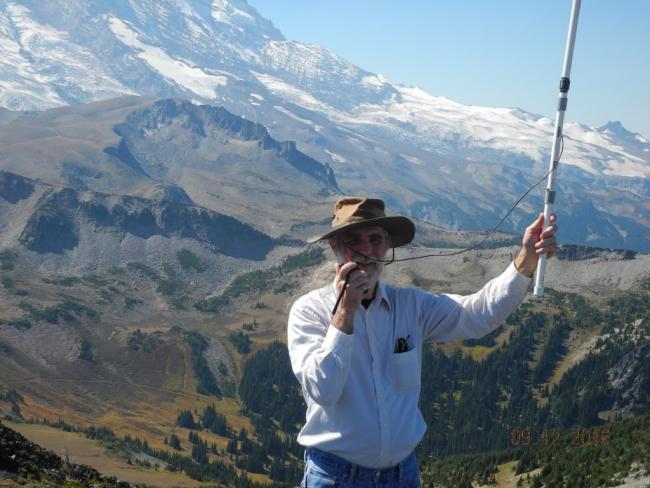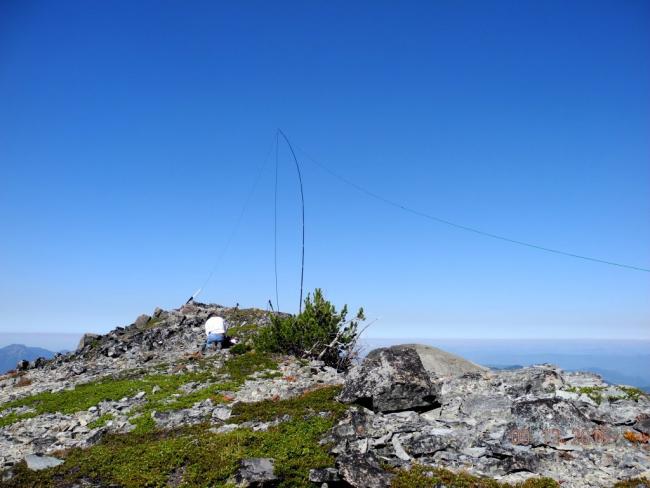On this Saturday of the NA SOTA Weekend, at about 10:45am, our party of four set out from Sunrise on Mt. Rainier to walk the Mt. Fremont Lookout trail. The Lookout promises spectacular northward views of the Grand Park meadows, and the entire trail is hugely scenic. More to the point, about ½ mile before the Lookout, the trail passes a few hundred feet below the summit of Mt. Fremont, and that was, of course, the real destination for the hams in the group: myself and Al N7OMS.
When we got to the point where Mt. Fremont was above the trail, the non-hams in the party were not inclined to ascend to the summit. There is no trail to guide this steep scramble up the west-facing slope over sharp and sometimes loose rock, where it’s also important to avoid trampling fragile vegetation. So we agreed to meet again on the trail in 90 minutes, and the others trekked on to the Lookout.
N7OMS and I carefully scrambled up toward the summit. Trekking poles were essential for testing the way and recovering balance when rocks shifted under our feet.
When we arrived, the view to the east was vertigo-inducing: a steep drop-off with a bit of scrub pine right at the edge to lash a mast to, a really nice place for an antenna.
First, we put together a collapsible half-wave 2M vertical made by SOTA mentor KR7W. While Al took pictures and a panoramic video, I turned on 146.52 and found it busy with other activators collecting summit-to-summit QSOs. We jumped in and quickly made 8 QSOs, of which 5 were S2S.
Then Al helped me set up the HB1B HF station. The 44-ft doublet went up easily on a 20ft collapsible fishing pole mast. The noise floor was QUIET, but the radio received some strange, intermittent, broadband noises, and also it wouldn't key. In something of a panic, I fiddled mindlessly with it for a few minutes and finally realized that the ground lead on my two-microswitch keyer paddle was broken. This must have happened in packing or on the trip, because it had worked the night before. Fortunately, I had brought an emergency straight key built from another microswitch.
My tuning arrangement now includes a Tayloe-style SWR bridge, which presents a nice load to the HB1B while the Z817 tuner is finding a match. (I blew up this radio last fall due to the lack of such a precaution.) But you have to remember to switch OUT the SWR bridge when you're done tuning.
For about 5 minutes I called CQ on 40M, with my thumb and microswitch-straight-key, before I realized I was putting out only 25% power (due to being in the "tune" position on the SWR bridge). More calling at full power elicited no responses on 40M, so QSY to 30M. No one was there either, so QSY to 20M, and at least there were signals. At this point, we had burned 55 of our 90 minutes, so I was relieved to get some responses to CQs on 20M. My fist (thumb) on the microswitch straight key was … imperfect. By the time I made 8 QSOs, we had 20 minutes to get back to the trail, so it was time to QRT.
Best HF QSO: WA7JTM was in AZ on Rim Road Peak, a 10-pointer, S2S. I think we could have worked lots more if we could have stayed longer. For unique states, we got WA, CA, NM, AZ and NC.
I was amazed to find that 20 minutes was enough to pack things up and descend to the trail, just as the rest of our party arrived. As we descended toward Frozen Lake, on the way back to Sunrise, a herd of 15 mountain goats crossed the trail ahead of us. We kept well back from them: several were kids, and the adults looked very robust.
I hesitate to suggest that everyone go out and activate Mt. Fremont. Although the scenery is spectacular and it’s pretty easy to get close to the summit, the last hundred yards or so is off-trail, steep, and a bit dangerous. We realized, on the way down, that it might be possible to start a rock slide, possibly even imperiling hikers on the trail below.
If you attempt this one, pick a day when there are not many other people on the trail, and be careful to respect the plant life eking out an existence at high-altitude.



